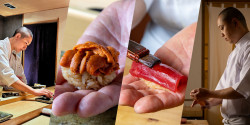
Originally published on metropolis.co.jp on July 2013
If you were ever curious about just what makes the tea ceremony such a Japanese thing, then Kristin Surak’s book, Making Tea, Making Japan, should answer your questions from all possible angles. This scholarly work presents and explores the significance of the utensils used, as well as the architecture and design of the space. It then moves on to the ritual’s role in Japanese history and the politics surrounding it, to how it transformed over time from a once-classless practice to a stratified activity within the political arena. What’s more, the book charts the evolution of the tea ceremony as a national practice and how it ended up in its modern rigid form mostly used by women.
Although Making Tea, Making Japan is an academic piece of sociological research, the author is not so coldly divided from her object of study. Surak’s passion and love for the topic emanate from the pages. She describes the minute details and significances of ceremonial etiquette—which might be infuriating for some—with a meticulous perfection: from how one enters the room, to how one moves and what one says. While her examination gives keen readers the chance to absorb the minutiae that make up temae (“tea preparation,” which includes hundreds of styles, each with their own specific name in Japanese), for those that are “just curious,” all this expert information could be a little overwhelming:
“The gap between the tea bowl and tea container should be the size of the caddy’s lid, and the scoop resting on the tea vessel should not protrude beyond the curve of the water jar to maintain a sense of balance from the main guests’ point of view.”
The book is divided in five chapters. Chapter one focuses on the technical aspects of the practice, the first step to understanding the difference between having a cup of tea and performing a Japanese tea ceremony. More interesting, though, is chapter two, which explains the history, the development and the present hegemonic form of the ceremony. The third chapter delves more deeply into the structure and politics surrounding the current form of the practice.
The opportunity to meet some of the characters who inhabit this unseen world is presented in chapter four. In an interesting piece of ethnographic collection, we finally get to hear some of this society’s individual voices. One male practitioner points out, “Now tea is a woman’s world, but it used to be men, true warriors at the center… that needs to be recovered. I wanted to do that, so I took it as a hobby.” An instructor from a famous iemoto (“school”) of the tea ceremony says: “We don’t have the KGB spying to see if you are doing things wrong… We’re not nearly as critical.” It’s quotes like these that bring to life the political structures still struggling within the world of tea.
The book’s final chapter looks at the interaction of the tea ceremony with the construction of “Japanese-ness.” According to Surak, the majority of the nation has never really experienced an actual tea ceremony. So, she asks, how did it come to be such a familiar national symbol? To find the answer, she scours the media and explores other cultural sources and influences. She makes some interesting comparisons with other countries that also enhance their national cultures by making national art forms out of ordinary practices, like the Turnverein, the German gymnastics movement, or the Indian Rashtriya Swayamsevak Sangh (RSS)—a nationalist paramilitary group that advocates physical training to revive the Hindu community.
This is not a simple guidebook to enchant novices and teach them the basic steps to get started in the Japanesese ritual of “tea.” But Surak’s comprehensive research will take those interested deep into the practice’s background and allow them to see the tea ceremony as a window into the soul of Japanese national identity. As a foreigner living in Japan, this book might well take you back to the moment you first arrived: a wide-eyed newcomer both in love with and resistant to the strict formality of life here—yet always fascinated by the unique traditions by which the Japanese make their nation.
Available at bookstores and via Amazon.jp







